The Fine Art of Contemporary Tattooing
From Anchors on Forearms to Colorful Sleeves
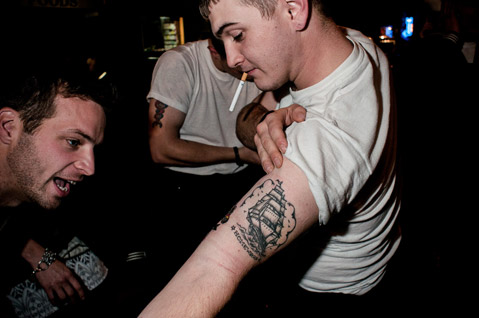
A person’s tattoos convey their personal history, excerpts from a diary painted in ink. More indelible than memory, tattoos have been used since the time of early humans to tell aspects of a story: to denote social status or communicate accomplishments. The history of the American tradition of tattoo art, brought to this country in the 1850s by sailors who’d visited Japan and the South Pacific, continues to evolve. It’s apparent on the streets; Santa Barbara has a thriving tattoo culture with reputable shops, world-class artists, and a population of willing participants.
Traditional American tattoo iconography had a sailor’s code attached to it. The nautical symbols we recognize in modern tattoos were affixed with meaning: Anchors denoted that a sailor had crossed the Atlantic; swallows marked 5,000 nautical miles traveled; a clipper ship showed the sailor had been around the Cape of Good Hope. Sailors wore their travels on their sleeves.
In the 1930s and ’40s, port cities like Honolulu and Norfolk, Virginia, were flush with tattoo shops and eager sailors, and artists like Sailor Jerry, Cap Coleman, and Paul Rogers began to distinguish themselves. Their work is the basis for many of the typical Americana-style tattoos that artists still incorporate into their modern work. The perpetuation of these designs and themes is a throwback to a now oft-romanticized period in American culture, despite the fact that sailors were seen as unsavory, which gave tattooing a deviant stigma.
Regardless of this association with a purported life of notoriety, the popularization of tattooing has continued at a steady pace toward mainstream. New generations of tattoo artists honed the craft and developed unique artistic styles. Mark Walters, a k a Permanent Mark, tattoo artist and owner of Golden Eagle Tattoo, described how the popularity of particular styles of tattoo art began to follow the trends of fashion.
“I remember when traditional tattoos weren’t popular,” Walters said. “When this Americana stuff started happening in the mid-’90s, I was in Amsterdam. It was the first time I’d seen a traditional American tattoo. There were only a few people still doing that stuff. In the early ’90s, we were all trying to reinvent the tattoo. Artists like Eddy Deutsche and Freddy Corbin in San Francisco would take a tribal tattoo and put a tartan pattern inside it. Bernie Luther would do portraits with tribal coming off of it. But the only people I’d get to tattoo traditional tattoos on were other tattoo artists. Nobody wanted it.”
Like the recurrence of high-waisted shorts and non-ironic moustaches, the popularity of the classic Americana tattooing style has recently returned to prominence. Santa Barbara, which boasts a thriving artistic community and conspicuous student population, is a perfect atmosphere for the gentrification of tattoo art. No longer on the fringes of society, tattoos that are considered a fashion choice rather than a utilitarian marking of status are represented by people along the entire socioeconomic scale. You see the ink peeking out from under women’s suit jackets when they drop their children off at school or on the back of your veterinarian’s neck when he adjusts his lab coat. The transformation of tattoos from acts of rebellion to expressions of beauty — from iconography to fine art — is apparent from The Biltmore to Del Playa.
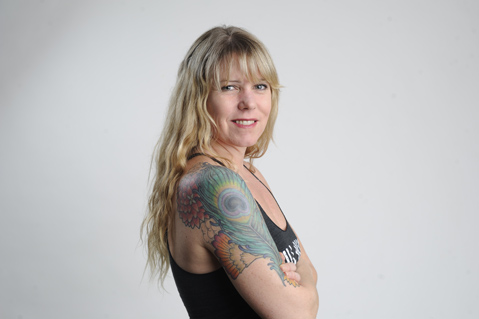
Painted People
Tattooing is an art form that involves a unique aspect of collaboration between the artist and the canvas. A tattoo artist will ideally work with their client to create a design that’s exclusive and specific. The canvas is alive, and carries the art through the world. Investing in a good tattoo is akin to investing in a framed painting, and people who are serious about their commitment to the tattoo subculture understand the importance of trusting your artist.
Jen Foster ✯ Photographer
Jen Foster is a wedding and portrait photographer at Z’s the Day Photography. She’s a native Santa Barbarian with a rebellious streak that led her to her first tattoo at 18. “I thought I was a tough chick,” she said of the spot on her upper arm, now part of a large, colorful mural. “I got a heart with a snake wrapped around it.”
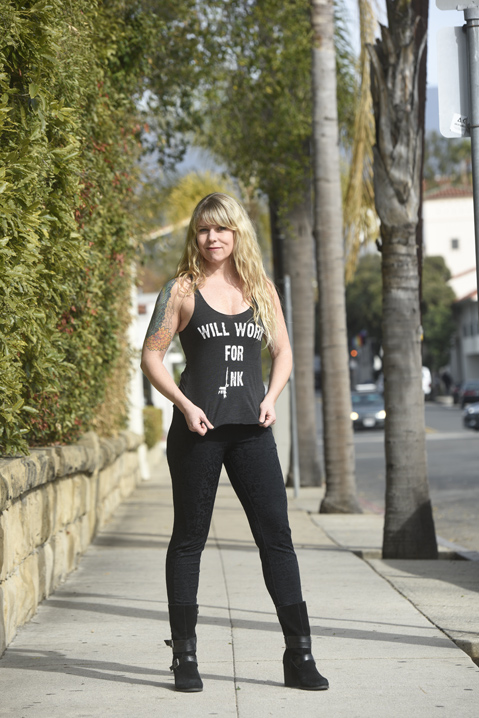
But as she grew up and her life changed, so did her tattoo. Finding an artist she worked well with creatively and personally has been the key to getting the best artwork possible. Foster’s artist, PJ Ferrante, only tattoos by appointment (though his wife, Nic Ferrante, heads up the all-female staff at Energy Tattoo & Body Piercing). PJ Ferrante tattoos Foster whenever she decides to add to — or alter — her existing pieces.
Foster’s original tattoo was covered, expanded, and then covered again. PJ added flowers to the background, and overlaid the heart with a peacock feather (twice). Her other tattoos have also been repurposed or absorbed into a larger image over the years to match her personal growth, a continual modification and beautification process made possible by her trust in Ferrante. “What I like now is not what I’m going to like in 20 years,” Foster said. “People ask what I’m going to do when I’m 80. I say by that time I’ll probably have covered it four more times.”
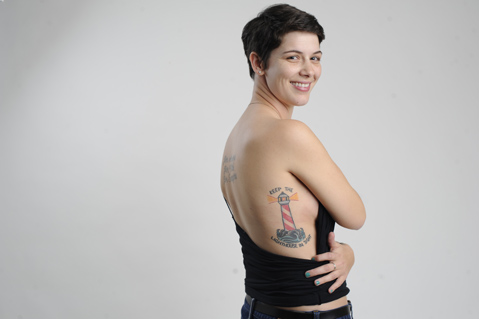
Katie Williams ✯ Associate Director of Programs and Member Services, YMCA
The specific message of classic Americana tattoos may be largely ignored in their modern manifestation, but the concept of the inked images as badges to mark life’s trials seems innate. Katie Williams, associate director of programs and member services for the YMCA, has several Americana-style tattoos that serve as indicators of certain eras in her life. For Williams, the image itself holds less meaning than the tattoo’s association with the moment in her life that inspired it. She describes her art as an act of validation rather than an act of rebellion. She views it as an investment in her ideal version of herself.
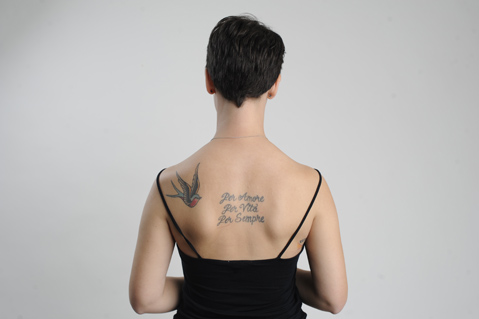
Raised in the rural Central Valley, Williams was fascinated by tattoos from an early age. “Especially coming from a blue-collar lifestyle, my experience of tattoos was being around the occasional grandfather or family friend who had old tattoos — real tattoos. Military tattoos and prison tattoos. I never knew anyone who got them for pleasure, for the sake of art.”
This is the gentrification process: the fashionable aspects of a tattoo are more accessible to modern culture than the utilitarian aspects, and these classic tattoos take on new meaning. The art has evolved but hasn’t lost itself completely. The lighthouse on Williams’s ribs, adorned with the phrase “Keep the Lighthouse in Sight,” is an example of a traditional tattoo that takes on the meaning the person assigns to it.
“The lighthouse — that’s a beacon for those at sea. For me it represents those moments of teetering, those moments that define who you are.” Williams, like the sailors, see these tattoos as permanent reminders of where she’s been.
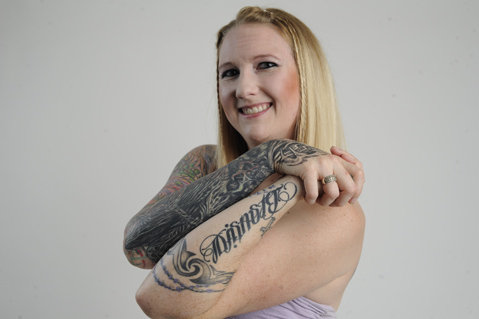
Janine Hall ✯ Bartender
Janine Hall shows me the back of her hand, the skin still puffy from the needle of a tattoo gun being repeatedly plunged into the flesh. It seamlessly turns into a full sleeve that continues over her shoulder and onto her back. Her experience describes a true commitment to the tattoo subculture. She’s wanted to get her hand tattooed for years, but it’s a big step. Tattoos on the hands, neck, head, and face are considered a more intense commitment than elsewhere on the body, especially for women.
Hall’s sleeve is an impressive tapestry of images depicting the journey between life and death. A memorial tattoo for an uncle who took his own life, the piece includes iconography such as a phoenix, the hand of god, and the all-seeing eye. The rest of her tattoos are a colorful hodgepodge in a bold blend of styles. Many of her pieces are products of her younger sister’s passing flirtation with becoming a tattoo artist — and needing a practice subject.
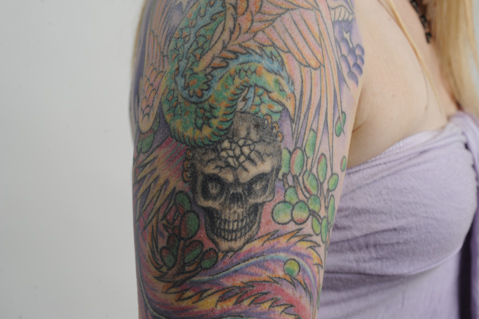
“In comparison to my professional work, my sister’s tattoos are not that great. But they remind me of who I was at that point, and I’d never take them back. I was my sister’s sketching board, her canvas to practice on.”
Being a young woman with extensive tattooing (especially in a restaurant environment) is an experience that invites all manner of unsolicited feedback. “The worst is when people assume they can touch you,” Hall said. “When you’re at a museum, there are signs that tell you not to touch the artwork. Just because I have tattoos doesn’t mean people can throw all personal regard out the door.”
Letting go of that fear of judgment was a conscious choice for Hall, and a marker of her emotional evolution. “I still get looks walking down the street, but I appreciate them, positive or negative. I want tattoos to be seen as the precious art form that they are. They are part of me. I’m not trying to be different,” she concluded. “I’m trying to be me.”

Rick Villa ✯ Theater Manager
Rick Villa manages the Marjorie Luke Theatre by day and writes punk-rock poetry as his performance alter ego, Rick Tragic, by night. Villa has written two books of poetry and is currently working on a third. His artistic persona, a modern take on the tragic hero, creates poetry inspired by punk and heavy metal music, with a flair for the theatric. While working on the poetry for his next book, Villa is simultaneously dreaming up possibilities for the accompanying tattoo.
“I have tattoos for both of my books,” he said. “For the first one, we used the same script as was on the book cover. The second book, The Descent, followed the tragic hero to the fall. The tattoo is the artist’s interpretation of that concept. It’s the story of the hero who crashes and burns.”
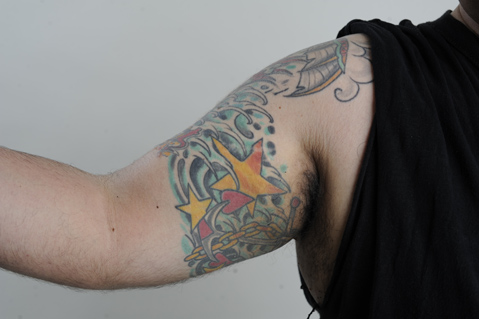
Heavily based on the unruly energy of punk music, the Rick Tragic character encapsulates that raw vibrancy and sense of fearlessness associated with the sailors’ classic nautical tattoos. For Villa, the association between tattooing and rebellion is strong. “I have a funny theory,” he said, and weaves a scenario in which tattooing hits a peak popularity before skipping a generation completely. “I don’t know when it’ll happen. Maybe the next generation. I think there will be a whole generation of people who don’t get any tattoos as a way to rebel against their tattooed parents.”
Tattoo Museums
The implication of tattoos has changed since 1850. Tattoos, in their most impressive and detailed forms, are finally being recognized as a fine art form. They maintain the same aspect of storytelling and expression of personal history that paintings and photography do, but it is an intimate and physical experience, created to be worn. A tattoo, in its best and most illustrative form, is a presentation of the adventure, heartbreak, and elation that define a personality.
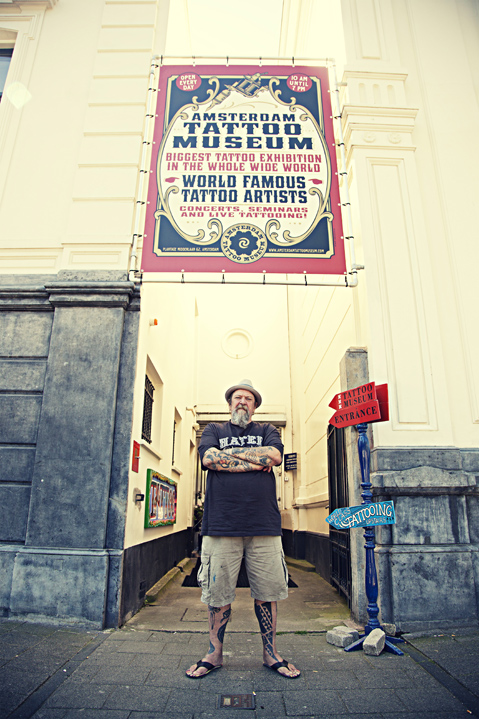
Some inked skin is being preserved for the ages. Tattoo artist Mark Walters gives an example: “I was working in Amsterdam, and a guy called and said they had half an arm in a jar for sale for 3,000 pounds. I offered to go to London and pick it up for my boss, who wanted to display it in the shop. He got me the money — it was probably drug money; it was all $2 bills. I was more worried about bringing a backpack of cash into London than I was coming back to Amsterdam with half an arm. It was in a jar, and I just put it in my backpack. It wasn’t like security nowadays. [The arm] was from about 1850. One side had a gigantic whale with a ship and a guy throwing a spear, all blue and hand-poked. The other side had a dock with a bunch of people with American flags. They were still perfect on the skin. I was on the plane, and there was a girl next to me, and I said, you want to see something weird? I showed it to her. Fifteen years later in Bali a girl comes up to me and said, I recognize you — you were the dude on the plane with an arm in your bag! Now Hanky Panky, my old boss and mentor, has it.
Where to Get Inked
Golden Eagle Tattoo. 407 State St. 897-3815.
805 Ink. 1228 State St. 845-5805. 805ink.com.
Energy Tattoo & Body Piercing. 428 State St. 564-6779. energytattoo.com.
Otherworld Tattoo. 33 E. Victoria St. 966-0971. otherworldtattoo.com.
Mission Tattoo. 104 W. Mission St. 563-1021. missiontattoo.com.
Luckyfish, Inc. 2007 State St. 962-7552. luckyfish.com.
Merkaba Tattoo. artbymallory.com.
Precious Slut Tattoo 3. 910 Embarcadero del Norte, Isla Vista. 685-7117.
Movement Ink. 6556 Pardall Rd., Isla Vista. 845-0387.
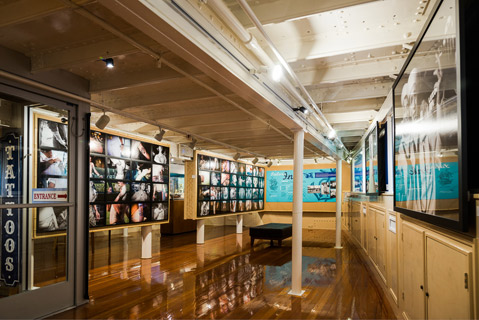
Art of the High Seas
To truly understand the present, it’s important to explore the past. To learn more about the traditions of American tattoo art, check out the Santa Barbara Maritime Museum exhibit Tattoos & Scrimshaw: The Art of the Sailor, running through August. This exhibit originated in Vancouver and has been presented previously in San Diego and Los Angeles.
The Santa Barbara version of this show features pieces from area tattoo artist Sebastian Orth of Otherworld Tattoo, including tools from his collection: antique needles for hand-poked tattoos, as well as examples of modern tattoo guns. Even better, if you run into Orth, he can tell you how to make a tattoo gun by taping household objects to a Walkman motor.
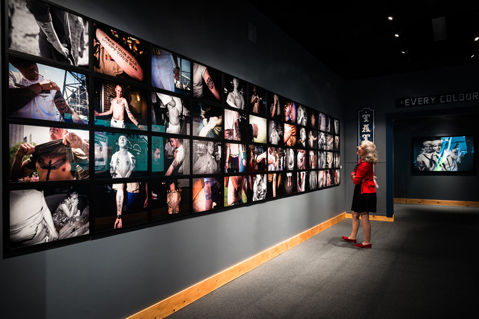
The exhibit also features the photography of Vancouver-based photographer Kathryn “Kitty” Mussallem. Mussallem’s been chasing the U.S. navy all over the world and has a fascinating collection of photographs featuring tattooed sailors. The photographs show the men and women of the navy at work (out at sea) and at play (Fleet Week in the ports) and illustrate the timelessness of the classic tattoo style and the connection it maintains with the culture of American sailors.
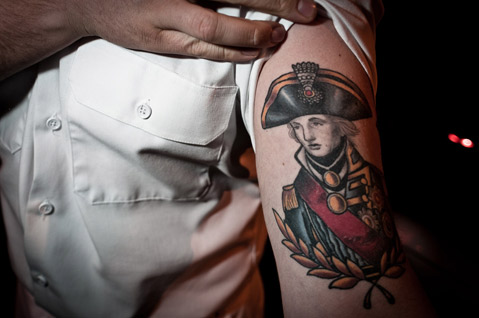
photographs in the exhibit.
The Maritime Museum’s exhibit features a unique marriage of historical and contemporary tattoo information with an emphasis on the classic American style. After a history of relegation to society’s fringes, it’s fascinating and encouraging to see the evolution of American tattoos into the world of contemporary art.
For more information, see sbmm.org/events.



